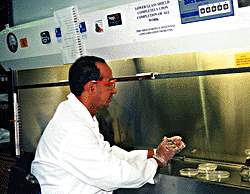| ||||||||||||||||||||||
University of Delaware Environmental Soil Chemistry Members In The News | ||||||||||||||||||||||
The News Journal Wilmington, Delaware June 5, 1998 | ||||||||||||||||||||||
Plant and Soil Sciences PH: (302) 831-2532 FAX: (302) 831-0605 | ||||||||||||||||||||||
 | ||||||||||||||||||||||
 | ||||||||||||||||||||||
University of Delaware Scores With Safety School earns top award from National Safety Council for protocols on how to prevent and handle accidents in labs, classrooms. By Stephen Sober Photo by Bill Hughes | ||||||||||||||||||||||
Mohamed Sedegui uses snake venom to help him identify strains of the fungus that caused the great Irish potato famine of 1845, a disease that also nearly threatened potato farms in Dover in 1995. University of Delaware safety regulations require him to wear safety glasses and gloves. A glass fume hood and fans are used to move the venom vapors away from where he works. Area hospitals know the venom is there and have antiserums ready, just in case the unthinkable happens. For good measure, Sedegui adds his own touch. "I always wear a mask," said Sedegui, who was just awarded a doctorate last week in plant pathology. Within research labs at UD, thousands of chemicals and radioactive materials are used every day by scholars like Sedegui to research new ways of fighting disease, improving agriculture and expanding our knowledge of physics. The university's safety protocols for dealing with -- and preventing -- possible accidents in its labs, classrooms and even dormitories have earned it the National Safety Council's highest safety award for a college campus. UD representatives will travel to New Orleans this summer to accept it. "It means that we have a well-developed, comprehensive and complete health and safety program,"said Robin Elliott, director of UD's Department of Occupational Health and Safety. "We have these programs because people need to know what to do in (the event of an accident). They do." Everything from administrative leadership and training programs to UD's handling of past accidents was considered in giving the award. Eve Brouer, a division manager with the National Safety Council, said the award is not competitive, but is given to all entering universities that meet strict criteria. UD scored 96 out of 100 possible points and was the only school to get the award this year, she said. "Delaware had top scores in almost every single category," Brouer said. "They have been effective in reaching all of their different audiences." That's no small feat, Brouer said. "Sometimes professors can be chauvinistic with safety issues, and students often feel they are immortal," she said. This was the first year that the university entered the contest, and probably for good reason, according to Jerry Hendricks, a research associate in environmental soil sciences who also is a university chemical hygiene officer. Hendricks said it was only recently that safety became an important issue among faculty, staff and students. "Traditionally, there hasn't been a culture of safety at universities, but it's coming along," Hendricks said. "It's been hardest with entrenched faculty members." As chemical hygiene officer, Hendricks helps train all who use the laboratories and nags them about the smaller things, such as wearing their safety glasses. "It's a problem to get people to wear them," he said. "If (the glasses) aren't comfortable, they won't." Back in the lab where Hendricks works, in the basement of Worrilow Hall, doctoral student Yuji Arai admitted he didn't like wearing the glasses. "They get all steamed up," he said. But he wears them. After all, the two share their lab with more than 360 chemicals and radioactive materials. Hendricks, surrounded by bins for disposing of chemicals and radioactive isotopes, pulls out a huge binder near the front door. Itís the manual that outlines all of the safety procedures for handling and disposing of each substance. Every person who works in the lab must read it. "Our policy is nothing goes down the drain," Hendricks said of the chemicals. Elliott said that during her time in the department (she started as a health physicist doing radiation safety in 1983) there has not been a serious accident that threatened lives. Part of UD's success in bringing safety to labs like Hendricks' is a recent expansion of the safety program, Elliott said. Since she took over in 1989, the staff has added four people for a total of 15 workers. There are more than 50 safety programs and 44 written safety policies at UD, she said, and each department has its own safety committee of faculty and staff that meets regularly and a deputized safety officer such as Hendricks. That's some progress for a department that started decades ago as one officer on the campus police force, Elliott said. But she admits that some still view the department as a "pain in the butt." "We work real hard not to be viewed like that, as a policeman," Elliott said. "But I think that | ||||||||||||||||||||||
 | ||||||||||||||||||||||
Home | Members | News | Links | Research | Meetings | Awards | Alumni | Publications | Search | ||||||||||||||||||||||
| ||||||||||||||||||||||
having people know what to do in the case of an accident is important." | ||||||||||||||||||||||

